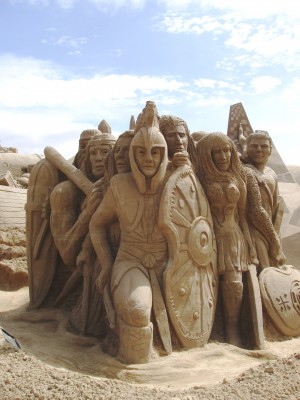Remy Geerts and Paul Hoggard Create Zero Impact Works of Art
Dutch artist Remy Geerts and British artist Paul Hoggard don’t need paint to create, nor do they need a canvas, paper, clay, or pastel. To craft a masterpiece, all they require is a sandy beach, water, a few tools, and their own four hands. With all those elements in check, they sculpt.
But their works aren’t your typical family vacation sandcastles. Geerts and Hoggard’s sculptures are large, small, and everything in between. Subjects range from animals and famous architecture to people and beyond.
“Sand is my chosen medium to express my inner feelings, aspirations and life experience. I only create with sand since I found my sandman, Paul, and now together we create sand magic,” Geerts said, describing her affinity for working with sand in an e-mail interview.
Geerts and Hoggard met in 2003 at a sand sculpture theme park–a sort of festival in which international sand sculpture artists work together on a theme of sculpture, often educational themes, such as Ancient Egypt or the Italian Renaissance—and have been working together ever since.
Their sculptures have been featured several times on BBC. Moreover, Geerts and Hoggard have been commissioned for countless advertisements, and have created for numerous festivals and events, such as the Royal Cornwall Show in 2006 for which they crafted a sand sculpture of Queen Elizabeth II.
“Sometimes clients ask us to create specific things, but most of our sculptures we develop ourselves. Inspiration can come to us while walking in nature, in meditation, or in our dreams. We find inspiration in abundance all around us,” Geerts explained.
“Our last job was to perfectly reproduce a Formula 10 Ferrari race car—for this we measured everything out and followed the drawings precisely. But other subject matters are more intuitive. And then we make it up as we go, working and problem solving our way down,” she added.
The artists sculpt their works of art from the top down, but first they must select the most suitable sand for the job. This depends on the sand’s consistency, as the water-to-sand ratio is very important. First Geerts and Hoggard wet the sand and compact it roughly into the desired shape. They then carve the sand, a process they call “blocking out.” Sculptures usually take the couple three to five days to complete and are about nine feet tall. Paul, however, once constructed a 62 foot tall depiction of South American gods.
“Paul lost 10 pounds in weight over the three weeks it took him and his fellow team members to create this monstrous sculpture. Paul says he has never done anything in life that scared him so much. Every second was dangerous, as sand wants to be a beach and not a mountain,” Geerts explained her partner’s biggest feat.
In fact, during the creation of this piece, one of their sand artist friends was nearly killed when an avalanche of sand nearly knocked him 50 feet to the ground. Hoggard managed to pull the man out of danger’s way just in time.
(Article continued on next page)

